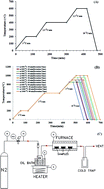Preparation and optimization of activated nano-carbon production using physical activation by water steam from agricultural wastes
Abstract
Production of activated nano-carbon from agricultural wastes was studied in this work. To obtain the optimum production conditions by a physical activation method, influence of temperature (850, 900, 950 and 1000 °C), activation residence time (30, 60 and 90 min), and mill rotation (200, 300 and 400 rpm) were investigated using three different raw materials including walnut, almond and pistachio shells. To prepare activated nano-carbon, all the samples were heated up to the final activation temperature under a continuous steam flow of 130 cm3 min−1, and at a heating rate of 3 °C min−1, and were held at the different activation temperatures for 30, 60 and 90 minutes. BET surface area of the obtained activated carbons was measured from nitrogen adsorption data in the relative pressure range between 0 to 1. Activated nano-carbon standard indexes were evaluated according to the ASTM standard and the samples were compared. First, the cellulose raw material was heated in the carbonization furnace at 600 °C and then activated in the advanced activation furnace at a temperature between 850 to 1000 °C for 30, 60 and 90 minutes with water vapor. Ash percentage, iodine content, moisture content, specific area, elemental analysis, and FESEM were used for product characterization. The results of the analysis showed that by using the water vapor physical activation method and optimizing the parameters of this process including time and rotation of the mill up to 10 min and 400 rpm, resulted in a significant increase in specific surface area, cavity volume and the iodine number of the final product.



 Please wait while we load your content...
Please wait while we load your content...